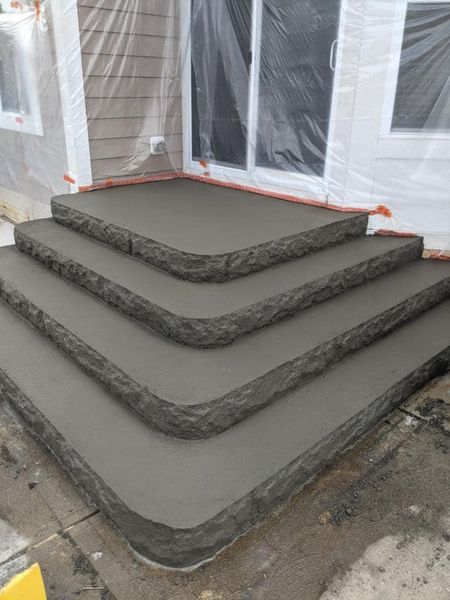%201%20(1).webp)
%201%20(1).webp)

The Importance of Quality Pavement Maintenance


How to Detect and Fix Concrete Scaling Problems in Columbus
Concrete surfaces around your home—like driveways, patios, and sidewalks—play an important role in daily function and overall curb appeal. When these surfaces begin to show signs of distress, such as scaling, it can compromise both appearance and safety. Scaling occurs when the top layer of concrete starts to peel or flake away, usually due to environmental exposure and other avoidable issues. It often starts small but can spread quickly if left untreated.
For homeowners in Columbus, local weather patterns can make concrete scaling worse. The freeze-thaw cycles that occur during the colder months can lead to moisture penetrating the concrete, then expanding when temperatures drop. That expansion pushes the surface layer away, eventually causing it to break off. If scaling is already showing on your concrete flatwork in Columbus, taking action sooner rather than later can help you avoid deeper damage and more expensive repairs.
Identifying Concrete Scaling
Spotting concrete scaling early can make a big difference. Surface damage may appear as light flaking or look like thin layers are peeling away. In some cases, you will see patches where the surface texture looks different, either rougher or more porous. It is not uncommon to notice white or dull gray areas that were not there before.
Common causes of concrete scaling include:
- Freeze-thaw cycles, especially when water sits on the surface and enters tiny pores before freezing
- Use of deicing salts during winter, which can accelerate surface deterioration
- Poor concrete finishing techniques, where excess water or improper curing weakened the surface
- Low-quality concrete mixes that do not hold up against constant moisture and temperature swings
- Lack of surface protection, like sealing, which may leave the concrete exposed to weather
In Columbus, these factors are common due to seasonal weather patterns. For example, if you have applied salt on your driveway every winter, that habit could be contributing to the problem. The combination of moisture, salt, and freeze-thaw cycles creates ideal conditions for scaling to develop. Checking exposed areas regularly, not just your driveway but also paths, outdoor landings, or patios, can help catch early signs before they get worse.
Assessing the Extent of Damage
Once you notice signs of scaling, the next step is figuring out how serious the damage is. Not all scaling is severe. In some situations, the issue is purely cosmetic and confined to the top layer. Other times, it may indicate deeper problems with the concrete’s integrity.
Here is a basic process to help assess the damage:
1. Walk around the concrete surface and mark out areas where flaking or peeling is visible
2. Press lightly on affected spots with a screwdriver handle or other blunt object. If the concrete crumbles or sounds hollow inside, the damage may go beyond the surface
3. Check how widespread the problem is. A couple of patches may suggest minor wear, but multiple sections across your flatwork could point to a need for more extensive work
4. Look at the depth of the peeling. Surface-level flaking that has not penetrated more than 1/8 inch is usually manageable. Anything deeper could call for professional repair
5. Consider the age of the concrete. Newer concrete showing signs of scaling may not have been properly cured or finished. Older concrete may simply be breaking down due to years of wear
For homeowners in Columbus, deciding whether to patch small areas or seek professional help depends largely on how widespread and deep the scaling is. If the peeling seems to be getting worse over time or affecting high-traffic safety zones, it is best to let our professionals take a closer look.
Fixing Minor Scaling Problems
When concrete scaling is spotted early and limited to the surface, repairs can often be handled before more serious problems begin. Minor scaling usually affects the top layer and does not involve structural damage. However, even small patches can lead to bigger issues if they are not addressed correctly and at the right time. During the late summer to early fall, scheduling repairs in Columbus is ideal since the temperature and moisture levels make it easier to apply certain surface treatments effectively.
While some homeowners may want to tackle the issue themselves, handling concrete resurfacing without training can result in uneven layers, trapped moisture, or worse long-term damage. That is why it is best to leave even minor repairs to experienced professionals who can control the materials, curing time, and surface consistency.
Our technicians typically follow this process for minor scaling:
1. Clean the damaged area thoroughly using high-pressure air or water to remove debris, loose concrete, and contaminants
2. Prepare the surface using mechanical scarifying or grinding tools to give the patching material a sound surface to bond to
3. Apply a bonding agent along the affected surface to help the repair material stick properly
4. Use a specialized resurfacing product designed to match existing concrete and apply it evenly over the prepared area
5. Allow for proper curing time and apply a fresh sealer to reduce future scaling
This kind of repair, when done the right way, brings back durability and appearance while protecting against moisture intrusion. A Columbus homeowner dealing with recent salt damage from last winter could see a quick improvement with these treatments, especially on exposed driveway edges and entry paths.
Professional Solutions for Severe Scaling
When scaling has spread to larger areas or is deeper than surface-level, it is no longer a minor maintenance issue. At this stage, you are more likely dealing with damaged material that can compromise the concrete’s strength. In many cases, this type of wear shows up in older concrete flatwork or in surfaces that were never sealed or properly poured.
Our professionals use structural-level repair processes for these conditions. These typically include full-depth patching or complete surface resurfacing, depending on the size and location of the damage. In some cases, slab replacement is the better option if the surface has deteriorated all over or if the cracks have allowed water to affect the base layer.
A few common professional methods for more advanced scaling include:
- Deep grinding to remove failing surface layers across larger sections
- Replacing isolated concrete panels when scaling is too advanced to patch
- Resurfacing the slab with an overlay material to restore the full surface appearance
- Applying a high-performance protective sealer to prevent future moisture problems
In Columbus, harsh winters paired with occasional overheating in summer can make it hard on unprotected concrete. That weather cycle is hard to push back against without the right maintenance program. Ongoing maintenance from trained professionals reduces the chance of relapsing into the same costly repairs year after year.
Maintaining Concrete Surfaces Post-Repair
Once a concrete surface is restored, keeping it protected should be a part of regular home maintenance. Homeowners in Columbus can take a few simple steps seasonally that make a measurable difference in reducing the chance of scaling coming back.
Here are some ways to maintain repaired flatwork effectively:
- Limit the use of deicing salts in winter. Instead, use sand to improve traction
- Rinse off any puddles, especially after snow melts, to stop water from soaking into the surface
- Keep downspouts directed away from concrete surfaces, helping avoid ponding
- Seal concrete every 2 to 3 years with a water-repellent, breathable sealer designed for outdoor use
- Address small surface issues promptly to stop them from progressing into wider damage
It is also smart to schedule yearly inspections each fall. This timing lets technicians identify wear before freeze-thaw cycles start, when scaling tends to accelerate. Surfaces like patios, driveway aprons, and sidewalk edges often take the most seasonal stress and should be reviewed ahead of winter.
Ensuring Long-Term Durability
Concrete flatwork in Columbus is always exposed to tough conditions, with winters being especially hard on untreated surfaces. While scaling may start out looking cosmetic, ignoring it can lead to deeper issues that affect more than just appearance. Regular monitoring, early detection, and proper repairs all help maintain the surface and save money over time.
Whether your concrete is only having minor flaking or you are dealing with surface layers shearing off completely, there is a solution when the issue is addressed at the right time. Working with professionals who understand the local climate and its direct impact on concrete is key. Every climate brings its own challenges, and Columbus is no exception. Catching the signs early and taking care of resurfacing or repairs with the right materials and techniques can add years to any concrete flatwork around your home.
If you are facing scaling issues that could affect your home's curb appeal, keep your property safe and inviting by tackling repairs before the damage worsens. At Professional Pavement Services, we understand the challenges homeowners in Columbus face with deteriorating concrete surfaces, and our skilled team is prepared to address these problems promptly. If you notice signs of wear on your concrete flatwork in Columbus, our experienced professionals can assess the damage and provide a long-lasting repair solution tailored to your needs. For a quick estimate or to schedule a service visit, please contact us today.
Recent Posts

Join Our Community of Readers
Stay updated with our latest insights and share your thoughts with us in the comments!


.svg)












.png)




